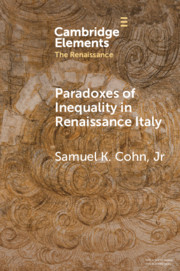Element contents
Paradoxes of Inequality in Renaissance Italy
Published online by Cambridge University Press: 15 July 2021
Summary
- Type
- Element
- Information
- Series: Elements in the RenaissanceOnline ISBN: 9781108980586Publisher: Cambridge University PressPrint publication: 05 August 2021
Bibliography
Primary Sources
Secondary Sources
- 3
- Cited by



